What if electrical stimulation could treat phantom limb pain?
Most people who have had a limb amputated will experience some form of phantom limb pain. Unfortunately, currently available drug treatments have varying success. Dr Katharine Polasek, at Hope College in the US, is investigating ways to use electrical stimulation to treat this painful phenomenon
TALK LIKE A NEURAL ENGINEER
AMPUTATION – the surgical removal of part of the body, such as an arm or leg
CENTRAL NERVOUS SYSTEM – consisting of the brain and spinal cord
EEG – abbreviation of electroencephalogram, which is a recording of brain activity using a special machine. Small sensors are attached to the scalp to pick up the electrical signals produced when brain cells send messages to each other
ELECTRODE – a small piece of metal or other substance that is used to take an electric current to or from a source of power, a piece of equipment, or a living body
NEUROPLASTICITY – the ability of the brain to form and re-organise synaptic connections, especially in response to learning, experiences or following injury
PERIPHERAL NERVOUS SYSTEM – consisting mainly of nerves, which are enclosed bundles of fibres connecting the central nervous system to every part of the body
REFERRED SENSATIONS – sensations felt in parts of the body far away from the site receiving the electrical stimulation
SOMATOSENSORY SYSTEM – the part of the sensory system concerned with the perception of sensations such as touch, pain, pressure and vibration
SURFACE ELECTRICAL STIMULATION (SES) – a non-invasive method of electrical stimulation which involves placing electrodes on the skin
Imagine losing your left arm, but months later you experience pain in your left hand, even though it is no longer there. This is known as phantom limb pain, the painful sensations amputees feel in their missing limbs. Even though the word ‘phantom’ might suggest otherwise, phantom limb pain is a very real and painful phenomenon, often described as throbbing, burning or stabbing in the part of the body that has been removed. It usually starts soon after the amputation surgery, and its duration and intensity vary from person to person.
Phantom limb pain is estimated to affect up to 80 percent of amputees and can be a long-term problem, so it is essential to find ways of managing and treating the pain. Unfortunately, finding a treatment to relieve phantom limb pain can be difficult, and there are no medications that are specifically aimed at this condition.
Dr Katharine (Katie) Polasek is an associate professor of engineering at Hope College in the US. Katie and her team are using their engineering skills to find innovative ways to relieve phantom limb pain.
WHAT CAUSES PHANTOM LIMB PAIN?
Scientists are still not certain about the exact mechanisms behind phantom limb pain, despite extensive research into the topic. It is most likely due to the brain and spinal cord continuing to send signals down to the nerves of the missing limb. However, no neural signals return and so the brain gets confused. It could be that the pathway (nerve to spinal cord to brain) that used to connect to the missing limb sends signals randomly, which causes confusion in the brain that is interpreted as pain.
“Some people have shown changes in their brain after an amputation where the area of the brain that used to connect to the amputated limb now responds to another nearby body location. For example, if you touch their face, a person with an amputated hand may feel the touch in their face AND in their phantom hand,” says Katie. “It’s not clear if this is a cause of phantom limb pain, but people who have more of this overlap often have pain.”
HOW IS PHANTOM LIMB PAIN CURRENTLY TREATED?
Current treatments for this condition have varying levels of success and do not directly address the neural changes mentioned above. Drugs for nerve pain are commonly prescribed to mask the pain, but these are covering up the issue rather than solving it and can have many negative side effects. Other options include acupuncture, massage and distraction techniques, but again, none of these really address the root of the problem.
HOW CAN ELECTRICAL STIMULATION BE USED AS A TREATMENT METHOD?
When small electric currents are passed through our skin, they activate sensors within the skin, producing a buzzing or tingly sensation that we can feel. This sending of electric currents is known as electrical stimulation. Sometimes electrical stimulation is used to turn on muscles after an injury in an athlete or to help people who are paralysed perform tasks such as grasping a fork or holding a toothbrush. It can also be used to evoke referred sensations, where the sensation is felt away from the site of stimulation. For example, Katie can place electrodes by someone’s elbow and use electrical currents to turn on fibres in the median nerve near the electrodes. The signal then travels up to the brain where it is interpreted. “If we activate the right fibres in the right way, we can make it feel like someone is tapping your hand!” says Katie.
The aim of these surface electrical stimulations is to give individuals with amputated limbs the very real impression that a non-painful sensation is happening in the missing body part. This is achieved by activating nerve fibres that used to come from the missing hand or foot, which Katie believes may help counteract phantom limb pain. “We think that allowing amputees to feel non-painful sensations in their phantom hand will reduce or eliminate phantom limb pain,” she explains.
Reference
https://doi.org/10.33424/FUTURUM180
AMPUTATION – the surgical removal of part of the body, such as an arm or leg
CENTRAL NERVOUS SYSTEM – consisting of the brain and spinal cord
EEG – abbreviation of electroencephalogram, which is a recording of brain activity using a special machine. Small sensors are attached to the scalp to pick up the electrical signals produced when brain cells send messages to each other
ELECTRODE – a small piece of metal or other substance that is used to take an electric current to or from a source of power, a piece of equipment, or a living body
NEUROPLASTICITY – the ability of the brain to form and re-organise synaptic connections, especially in response to learning, experiences or following injury
PERIPHERAL NERVOUS SYSTEM – consisting mainly of nerves, which are enclosed bundles of fibres connecting the central nervous system to every part of the body
REFERRED SENSATIONS – sensations felt in parts of the body far away from the site receiving the electrical stimulation
SOMATOSENSORY SYSTEM – the part of the sensory system concerned with the perception of sensations such as touch, pain, pressure and vibration
SURFACE ELECTRICAL STIMULATION (SES) – a non-invasive method of electrical stimulation which involves placing electrodes on the skin
Imagine losing your left arm, but months later you experience pain in your left hand, even though it is no longer there. This is known as phantom limb pain, the painful sensations amputees feel in their missing limbs. Even though the word ‘phantom’ might suggest otherwise, phantom limb pain is a very real and painful phenomenon, often described as throbbing, burning or stabbing in the part of the body that has been removed. It usually starts soon after the amputation surgery, and its duration and intensity vary from person to person.
Phantom limb pain is estimated to affect up to 80 percent of amputees and can be a long-term problem, so it is essential to find ways of managing and treating the pain. Unfortunately, finding a treatment to relieve phantom limb pain can be difficult, and there are no medications that are specifically aimed at this condition.
Dr Katharine (Katie) Polasek is an associate professor of engineering at Hope College in the US. Katie and her team are using their engineering skills to find innovative ways to relieve phantom limb pain.
WHAT CAUSES PHANTOM LIMB PAIN?
Scientists are still not certain about the exact mechanisms behind phantom limb pain, despite extensive research into the topic. It is most likely due to the brain and spinal cord continuing to send signals down to the nerves of the missing limb. However, no neural signals return and so the brain gets confused. It could be that the pathway (nerve to spinal cord to brain) that used to connect to the missing limb sends signals randomly, which causes confusion in the brain that is interpreted as pain.
“Some people have shown changes in their brain after an amputation where the area of the brain that used to connect to the amputated limb now responds to another nearby body location. For example, if you touch their face, a person with an amputated hand may feel the touch in their face AND in their phantom hand,” says Katie. “It’s not clear if this is a cause of phantom limb pain, but people who have more of this overlap often have pain.”
HOW IS PHANTOM LIMB PAIN CURRENTLY TREATED?
Current treatments for this condition have varying levels of success and do not directly address the neural changes mentioned above. Drugs for nerve pain are commonly prescribed to mask the pain, but these are covering up the issue rather than solving it and can have many negative side effects. Other options include acupuncture, massage and distraction techniques, but again, none of these really address the root of the problem.
HOW CAN ELECTRICAL STIMULATION BE USED AS A TREATMENT METHOD?
When small electric currents are passed through our skin, they activate sensors within the skin, producing a buzzing or tingly sensation that we can feel. This sending of electric currents is known as electrical stimulation. Sometimes electrical stimulation is used to turn on muscles after an injury in an athlete or to help people who are paralysed perform tasks such as grasping a fork or holding a toothbrush. It can also be used to evoke referred sensations, where the sensation is felt away from the site of stimulation. For example, Katie can place electrodes by someone’s elbow and use electrical currents to turn on fibres in the median nerve near the electrodes. The signal then travels up to the brain where it is interpreted. “If we activate the right fibres in the right way, we can make it feel like someone is tapping your hand!” says Katie.
The aim of these surface electrical stimulations is to give individuals with amputated limbs the very real impression that a non-painful sensation is happening in the missing body part. This is achieved by activating nerve fibres that used to come from the missing hand or foot, which Katie believes may help counteract phantom limb pain. “We think that allowing amputees to feel non-painful sensations in their phantom hand will reduce or eliminate phantom limb pain,” she explains.
HOW FAR IS THE TEAM INTO THIS RESEARCH?
Having investigated effective ways to activate referred sensations, Katie’s team carried out further investigations to find out how to best evoke a ‘natural’ sensation in subjects with an amputation. They stimulated different areas of the skin at different frequencies and asked the subjects questions about what they felt.
Katie and her team have successfully developed a technique to electrically stimulate on the skin at the elbow or knee, but for the participant to feel the sensation in their hand or foot. This occurs in people both with and without amputations.
The team is aiming to evoke a ‘natural’ sensation, meaning that the sensation felt by the amputee matches a common feeling. A tap on the skin is a good example, says Katie. “It’s very common to feel a tingling sensation or pins and needles due to electrical stimulation, however it’s hard to do something to someone that looks like pins and needles. We don’t like it when our sensations don’t match!” Tapping is something that I can do on someone’s hand or prosthesis as part of the therapy.
The researchers are investigating what happens in the brain when an amputee experiences an actual touch versus an electrically stimulated touch. So far, they have studied the brain by looking at EEG signals in people without amputations to see how they respond to different types of touch. Katie’s team is working to make the referred sensation as realistic as possible. After this, the researchers will begin testing their electrical stimulation therapy on people with amputations, recording their brain signals during therapy and seeing whether their brain begins to respond differently. This will help us learn more about the causes of phantom limb pain.
WHAT ARE THE FUTURE IMPLICATIONS OF USING ELECTRIC CURRENTS TO TREAT PHANTOM LIMB PAIN?
Katie hopes that her work will lead to customised therapies for phantom limb pain. She also aims to develop a tool for patients to use at home, making it far easier for people to access treatment. “I would hope that we can provide an inexpensive, at-home treatment for people suffering from phantom limb pain to do on their own. I would like the therapy to be effective and maybe a little fun, so that people will actually do it,” she says. Moreover, by exploring ways to tap into our nervous system and target pain without invasive treatment or drugs, this research could pave the way for therapies for many other neurological conditions.
 DR KATHARINE POLASEK
DR KATHARINE POLASEK
Associate Professor of Engineering
Hope College, USA
FIELD OF RESEARCH: Neural Engineering
RESEARCH PROJECT: Treating phantom limb pain with electrically induced somatosensation
FUNDER: National Science Foundation
 DR KATHARINE POLASEK
DR KATHARINE POLASEK
Associate Professor of Engineering
Hope College, USA
FIELD OF RESEARCH: Neural Engineering
RESEARCH PROJECT: Treating phantom limb pain with electrically induced somatosensation
FUNDER: National Science Foundation
ABOUT NEURAL ENGINEERING
Did you know that fully functional bionic arms have been developed for amputees that respond to signals from the brain? The user only has to think about moving their hand, and signals from the brain will be detected by electrodes in the bionic arm, causing it to move! This life changing invention is all due to the work of neural engineers.
Neural engineering is a discipline within biomedical engineering. It focuses on using engineering techniques and skills to understand, interface with and manipulate the nervous system. Neural engineers are interested in understanding how the brain functions, and often create computer models of neural systems to better understand them and how they interact.
WHY DO WE NEED NEURAL ENGINEERS?
Neural engineers are essential for many medical-related technologies and therapies. They might design heart devices such as pacemakers or defibrillators, or develop brain devices to help people with Parkinson’s disease or epilepsy, or work on therapies to help people who have suffered from a stroke or spinal cord injury.
DOES KATIE RECOMMEND A CAREER IN NEURAL ENGINEERING?
“Neural engineering is a pretty narrow field, but I love learning about how the different parts of the body communicate and work together to allow us to do all of the amazing things that we can do,” she says. “As a neural engineer, I have to understand what the body is doing so that I can use my engineering skills to restore function that was lost, or take pain away.”
EXPLORE A CAREER IN NEURAL ENGINEERING
• You can read more about neural engineering on the IEEE Engineering in Medicine & Biology Society website: www.embs.org/about-biomedical-engineering/our-areas-of-research/neural-engineering/
• The Royal Academy of Engineering also has a handy guide: www.raeng.org.uk/publications/reports/neuralengineering-briefing
• Neural engineering is a specialised field, so it is useful to read up on the more general field of biomedical engineering. UCAS provides a great summary: www.ucas.com/ucas/after-gcses/find-career-ideas/explore-jobs/job-profile/biomedical-engineer
• Practical experience is a good way to find out whether neural engineering, biomedical engineering or engineering in general is the career for you. Hope College hosts ExploreHope which, as Katie says, “runs awesome engineering camps for older kids.” Research the engineering departments of universities near you to see if they hold similar camps or outreach activities for schools and students.
• Katie recommends finding a neural engineer and shadowing them, if possible. “Once you get to engineering school, apply for an internship or research experience so that you can start doing real science and/or engineering,” she says. “The best way to know if you like something is to try it out!”
• According to Indeed, the average salary for a neural engineer in the US ranges from $91,000 – $150,000, though this will vary depending on your qualifications and whether you work for a company or at a university.
Maths is essential for all forms of engineering. In addition, Katie suggests learning electrical engineering concepts and computer programming. Katie took other science courses about the human body and her favourites were in anatomy and physiology.
HOW DID KATIE BECOME A NEURAL ENGINEER?
WHAT WERE YOUR INTERESTS WHEN YOU WERE YOUNGER?
As a child, I always loved to let my imagination take over, using toys and dolls to create new worlds, and I have many happy memories of playing with siblings and friends that way. I loved reading fantasy books, especially those of Madeline L’Engle. As I grew older, I enjoyed playing piano and trombone, and running track and cross-country. I’ve also loved jigsaw puzzles all of my life.
DID YOU ALWAYS KNOW YOU WANTED TO BE AN ENGINEER?
My father is a civil engineer, so I was exposed to engineering at a young age. I didn’t really have an interest in designing bridges or cars, so I didn’t plan on becoming an engineer initially. When I was 4, I wanted to be a monkey doctor. This progressed to baby doctor, then veterinarian, so I guess I was mostly focused on the medical field. It was in my junior year at high school that I first heard about biomedical engineering, and it sounded perfect for someone like me who was definitely interested in how the body worked but also liked math and solving problems.
YOU HAVE A BSE IN MECHANICAL ENGINEERING AND A PHD IN BIOMEDICAL ENGINEERING. WHY DOES BIOMEDICAL ENGINEERING FASCINATE YOU?
When I was in high school, I remember being fascinated with how muscles produced movement. My favourite muscle was the zygomaticus major – the smiling muscle! In my anatomy and physiology class, I learned the secrets to how muscles contract and create complex movements. Once I started studying engineering, I wanted to learn more.
HOW WOULD YOU DESCRIBE YOURSELF?
I like to solve problems and am very practical and hands on. I have trouble visualising things that people tell me verbally, so I like to see the problem or draw it, based on a description. Seeing the problem helps me to find a solution.
WHAT DO YOU ENJOY OUTSIDE OF RESEARCH?
I love my work but I also love coming home at the end of the day to my husband Greg and my three boys, Isaac, Teddy and Sam. We also have two dogs and two cats who are always available for pets and snuggles. For my hobbies, I still keep up with running and playing the trombone but I added hockey as an interest when I was in graduate school. Hockey is fun and social, and a great way to exhaust myself and be part of a team.
KATIE’S TOP TIPS
01 Don’t expect getting into a specific career to be a straight path, and don’t worry if you’re not sure what you want to do.
02 At each stage in your career, make the best decision for you at that time. It’s good to have a long-term plan but life often doesn’t work out exactly as you planned!
Do you have a question for Katie?
Write it in the comments box below and Katie will get back to you. (Remember, researchers are very busy people, so you may have to wait a few days.)

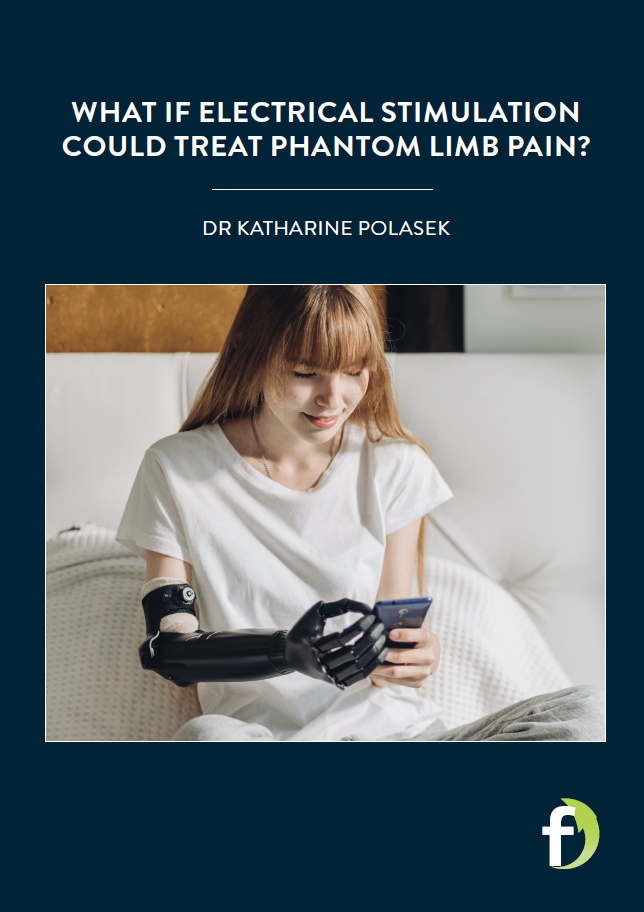
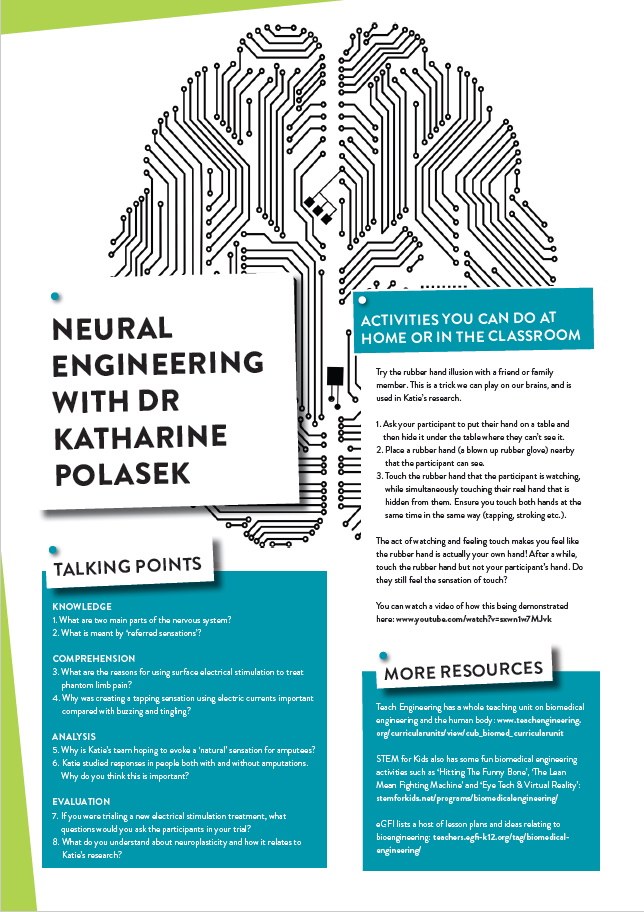
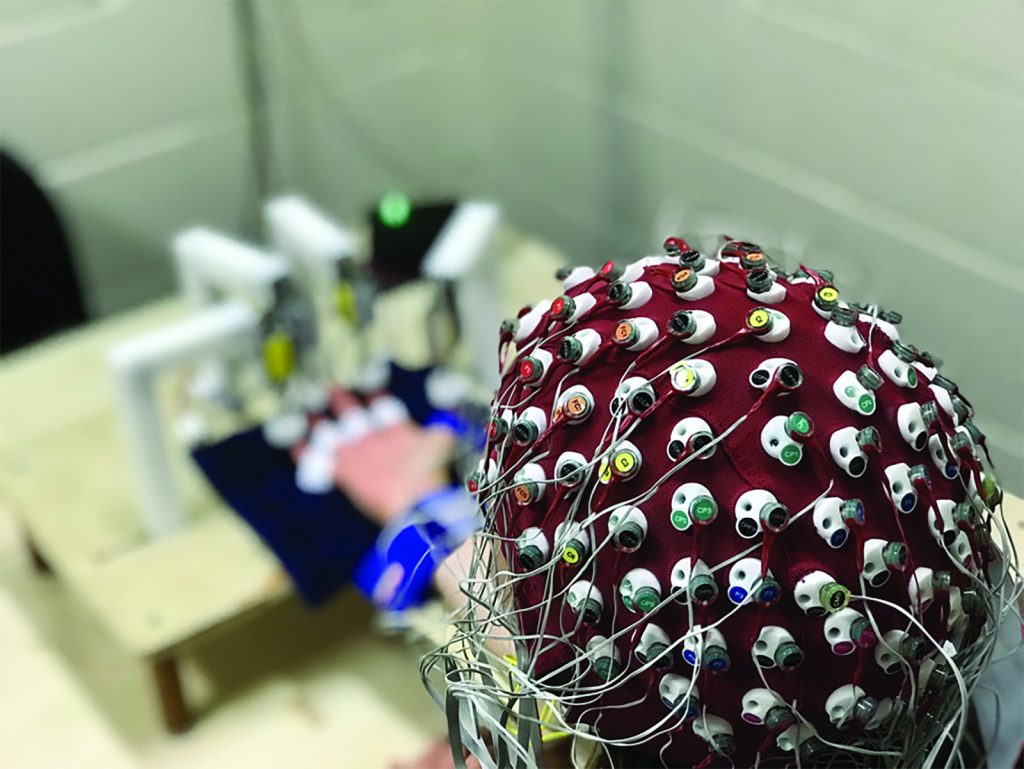
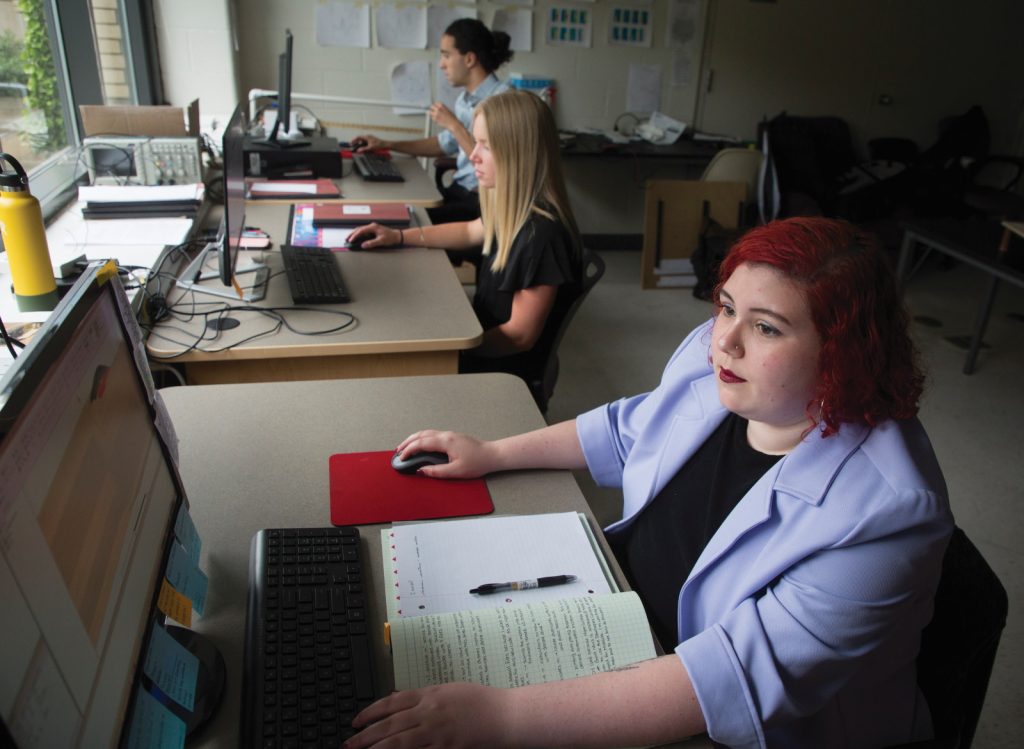

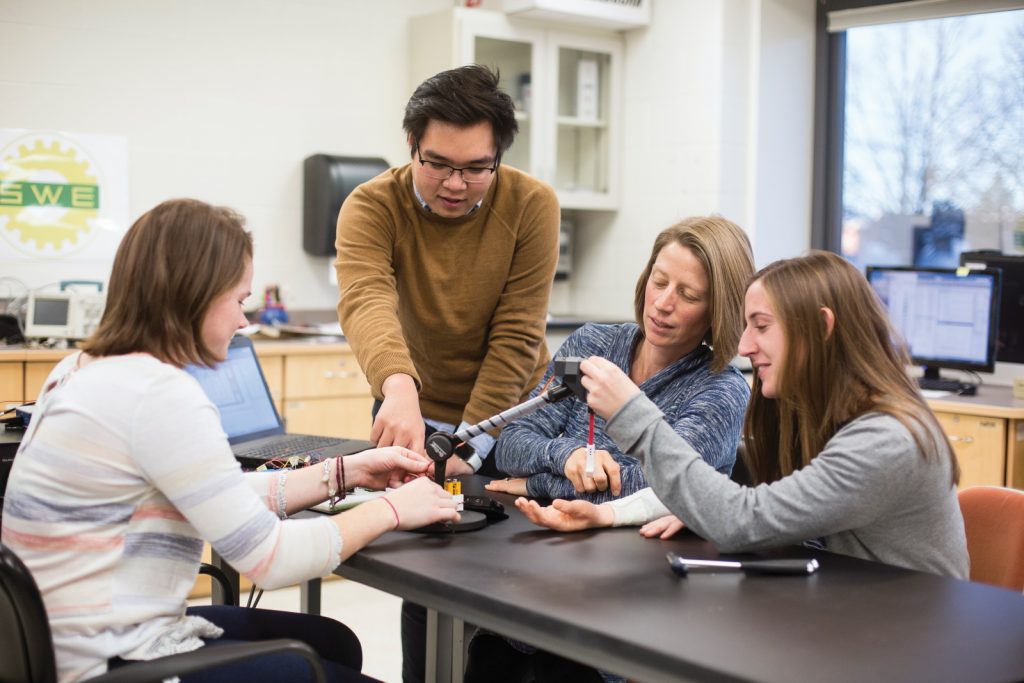


Hi Katie Are you aware of any research using electrical stimulation and ALS patients? Your research is very impressive, my son has ALS and I would be interested in exploring that. By the way I remember you from our trips to Honduras !!!
Hi Katie! I’m sorry to hear about your son’s diagnosis, ALS is hard. I know people have looked at electrical stimulation for slowing the progression of ALS but I don’t know the details. Restoring function electrically and getting assistive devices is especially difficult since ALS is a progressive disease. Once you get things set up, the disease changes and the device no longer works. My first personal contact with someone with ALS was with one of the Honduras trip leaders when I first started going. Lots of Honduras memories!